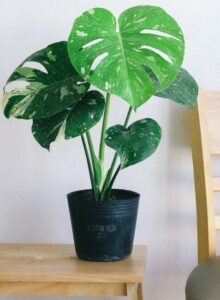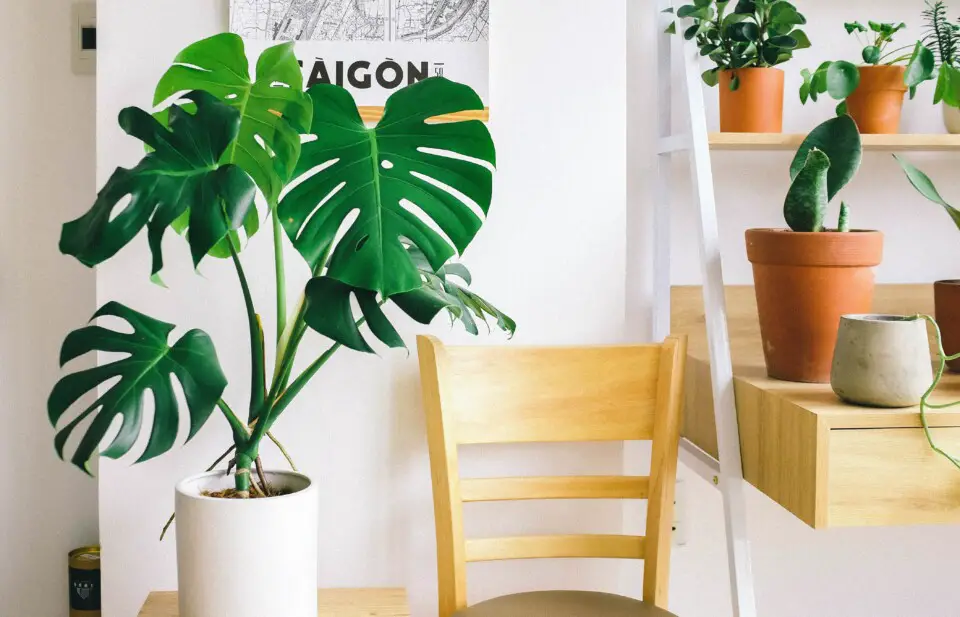Some links in the post are affiliate links and I get a commission from purchases made through some links found in the post.
Monstera deliciosa, which you may also know as the Swiss Cheese plant or split-leaf philodendron is a plant which is native to tropical areas such as southern Mexico and Panama.
It grows in many other places and is also very popular as a houseplant.
In its natural conditions the Monstera can easily grow up to 20 metres in height, with enormous glossy leaves. The main attraction of the Monstera is the split leaves which can measure between 10 and 35 inches across.
If you have been nurturing your Monstera for about two years you should have large leaves by this time.
If your Monstera seems underdeveloped and has small leaves you may begin to question your maintenance schedule, and you would be right to do this.
Small uninspiring leaves on a Monstera are normally related to impacted growth, and while the issue about small leaves may be difficult to diagnose, there are in truth only a few reasons for Monsteras to have small leaves.
The reason your monstera has small leaves may be due to inadequate light, too little water, too much water, the quality of the water, the plant needs repotting and the plant needs fertilizer.
Why does my Monstera have Small Leaves?
1) Check the Light
 Possibly the most common reason for a Monstera to have small leaves is because it is not getting enough light. If your Monstera does not get enough light it will become stressed.
Possibly the most common reason for a Monstera to have small leaves is because it is not getting enough light. If your Monstera does not get enough light it will become stressed.
You will notice that any new developing leaves are smaller than the older leaves.
You may even find that your Monstera does not develop split leaves as it should. The leaves may also appear thin and of a lighter colour.
How do we fix this?
Your Monstera needs at least 6 hours of bright, indirect sunlight each day to do well and develop. They prefer windows which face east, west, or south, rather than north facing windows.
Dappled light works for the Monstera but it will not develop well in shade or in direct sunlight.
If you do not have a good window to place your Monstera in then you may consider some form of artificial lighting. Grow lamps are an excellent choice where the light from windows is not enough.
2) Too Little Water
Like any other plant, your Monstera needs water. If the leaves are underdeveloped then you should check how much water the plant is getting.
Underwatering a Monstera can harm it and prevent it from growing into the dramatic plant that it is known for.
Too little water will make the soil dry out and the leaves will start to droop. New leaves will not grow as large as the older leaves.
How do we fix this?
The easiest way to check if the plant needs water is to stick your finger into the soil. If after the first inch in the soil you feel it is dry, then your Monstera is not getting enough water.
For most people it is enough to water the Monstera once a week, although you should not rely on this.
Rather, do your own check to make sure the plant is getting enough. Take into account the humidity factor in your home as this could dry the soil out.
The type of pot can also influence the dryness of the soil. Plastic pots tend to hold moisture while crock pots will allow water to evaporate faster.
3) Too Much Water
Overwatering can do far more damage than underwatering and can also lead to fungal infections and root rot.
Too much water will mean new leaves do not grow large and split. You may also find infestations of gnats if your Monstera is constantly in boggy soil.
How do we fix this?
Again, stick your finger into the soil. If it is sodden down at the 1” mark then this is a sign that the plant does not need to be watered as often.
Check the base of the pot to ensure that there is adequate drainage and if not, then repot the plane into a pot which has more holes in the base.
You should let the plant dry out completely before watering it again.
4) Your Plant needs Repotting
For a Monstera to develop those beautiful large leaves it needs to have space to spread its roots out. If the roots do not have space to grow the leaves will not develop well.
Because the Monstera can grow to such a huge height it needs enough room for its root system to support the top growth. In a pot which is too small the roots will not become strong enough to support the plant.
How do we fix this?
Generally, the Monstera needs to be repotted every two years. Indeed, repotting the plant will encourage new leaves to form and grow big.
If you are unsure about whether you should repot your Monstera, then lift the pot up and look at the drainage holes. If you see small roots over the holes or growing out of them, then it is time to repot your plant.
5) Your Plant needs Fertilizer
Like most other plants your Monstera will benefit from fertilizer. All plants need certain nutrients such as potassium and nitrogen to grow and develop. If they do not get enough vital nutrients the leaves will not develop.
How do we fix this?

If you are in the process of repotting your Monstera then you will not need to fertilize it right away because the new potting mix will be nutrient rich. However, if you plan on repotting your Monster in a year or so, then it will appreciate the fertilizer.
It is recommended that you dilute the liquid fertilizer to half strength so as not to burn the roots. The plant will appreciate this once a month during the growing season.
6) Check the Water
Occasionally the water from the faucet is too hard for Monstera’s do grow well.
Hard water contains calcium, chlorine and sometimes fluoride which will over time build up in the soil and prevent the plant from absorbing any other nutrients. This will result in smaller leaves.
The effect of hard water on the Monstera is similar to a lack of fertilizer.
How do we fix this?
Do not be fooled by thinking that bottled water from a spring is good for your plant, because in truth this type of water very rarely comes from springs and can be as bad for your plant as hard water.
Opt for rainwater or filtered water. Building a water butt to collect rain is a great idea for all your indoor plants, particularly your Monstera.
You may also like: How to care for a monstera
How do you Make Monstera Leaves Bigger?
A point to remember about Monstera and small leaves is that large leaves are a sign of a happy older plant.
New, young Monsteras will not develop those lovely large leaves until they are a few years old. Be patient and if your Monstera is in the right conditions, it will develop large leaves as it gets older.
Of course, all the conditions like light, water, and pot size will play a part in the leaf development of the Monstera, but if these conditions are met, there is no reason why your Monstera will not develop large leaves.
If we remember the natural conditions of the Monstera we see that sunlight is a very significant fact in the development of large leaves. If your Monstera is growing outside then it must have indirect sunlight, and at least six hours of it.
Also if you cannot replicate the lighting inside, then consider a grow lamp, or move the plant to another spot.
Why are my New Monstera Leaves Getting Smaller?
The reason for new leaves to be underdeveloped is because conditions have changed from being ideal to being less than perfect for your Monstera.
Small leaves can be a sign of nutrient deficiency, underwatering or overwatering, a pot that is too small and inadequate light. All these conditions will mean that any new leaves will be smaller.
Can we fix this?
Fortunately, we can fix leaves which seem to be getting smaller. This is done by simply changing the things which are not ideal for your plant. In fact, all these conditions are easily rectified if we see them early enough.
Monitor your Monstera and keep a record of watering times, repotting dates and fertilizing times and you will soon see why the leaves are smaller.
There are only a few things which will influence small leaves, and all of them can be easily changed.
Final Thoughts
 Generally speaking, you can expect to see at least one new leaf appear every 4 – 6 weeks so if you notice that the emerging leaf seems smaller, not too much damage has been done and you can easily ensure future leaves are bigger.
Generally speaking, you can expect to see at least one new leaf appear every 4 – 6 weeks so if you notice that the emerging leaf seems smaller, not too much damage has been done and you can easily ensure future leaves are bigger.
Do remember that a very young Monstera will have smaller leaves simply because it is a new plant. Large leaves come in plants that are older.
As your Monstera ages it will – if conditions are right – produce more leaves each month. By just changing some conditions for your Monstera there is no reason why in a few years you do not have a glorious Monstera with large, glossy leaves.

